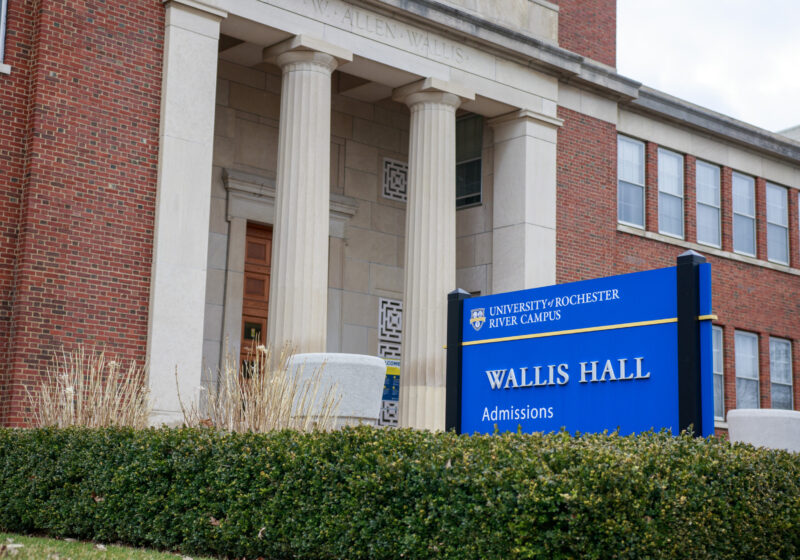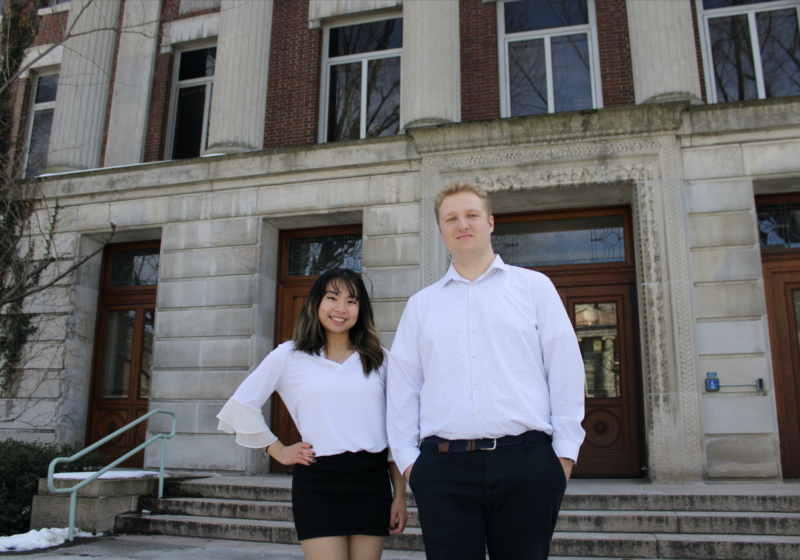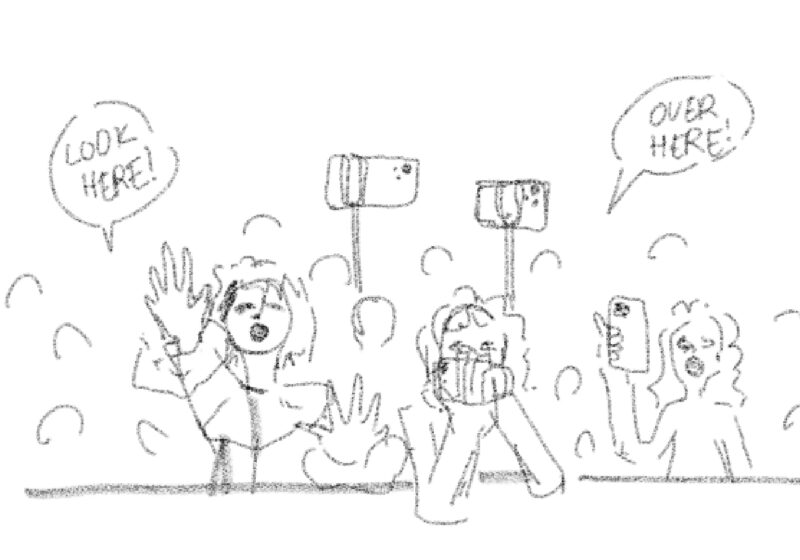UR students, faculty, and community members have engaged in a series of protests against recent decisions by grand juries in St. Louis County, Missouri and Staten Island, New York not to indict police officers Darren Wilson and Daniel Pantaleo for, respectively, the deaths of Michael Brown and Eric Garner.
Most recently, on Friday, Dec. 5, students held a die-in and march as the first “Ferguson Friday” event on the UR campus. Civil rights groups around the country have held Ferguson Friday protests since the August shooting death of the 18-year-old Brown.
Protesters gathered before the march in the Ruth Merrill Center to plan the day’s events and divide into groups. Senior Makia Green, an organizer of the event, said to protesters that this was the first of what will be “regular actions” to mobilize students for civil rights.
Participants split into groups for their die-ins. The smaller group went into the tunnels and first blocked the end of the painted tunnel underneath Hoyt Auditorium, then the tunnels leading to the staircase to Rush Rhees Library. Some protesters lay down in a die-in position to simulate Michael Brown lying on the ground for hours after he was shot. Students passing by turned around rather then step over the protesters.
The other group blocked the entrance to the Starbucks in Wilson Commons. Some protesters lay down while others formed a circle and held up their hands in the “Hands up, don’t shoot” position common to protests.
After about forty-five minutes, the tunnels group joined the group in Wilson Commons, and the congregation began to chant such slogans as “No justice, no peace, no racist police,” “Turn up, don’t turn down, we do this for Mike Brown,” and the call-and-response of “Tell me what democracy looks like; this is what democracy looks like.”
Senior Amber-Danielle Baldie, an organizer of the protests, spoke to the group at Starbucks about the motivations for the movement.
“We should all be upset about how our justice system works. We have the privilege to ignore what’s going on around us.”
Green said that “we want to reach everyone– we are a part of the Rochester community.”
The group then moved to the Brooks Crossing footbridge while chanting “Black lives matter,” the motto of the nationwide movement that arose in the wake of the death of Michael Brown.
Once at the bridge, the students tied to the railings black balloons with the names of black men and women killed by police written on them. While the protesters tied the balloons, they chanted “I got my hands on my head, don’t shoot me dead.”
The students returned to the Ruth Merrill Center where they debriefed and planned future protests. Before parting ways, they recited a chant that they said they had learned from Dhoruba Shakur, a civil rights leader based out of St. Louis: “It is our duty to fight. It is our duty to win. We must love and support each other. We have nothing to lose but our chains.”
Green warned the protesters not to attend a planned pro-police rally in Rochester the following day. She said that there were rumors that there would be a KKK presence at the rally. She reminded the protesters that police officers are not to be antagonized and that “[the police’s] job is to protect and to serve; we just want them to do their job.”
The pro-police rally was cancelled “in the interest of public safety and community harmony,” according to a press release by the Rochester Police Department.
Students walk out of class to show solidarity
On Monday, Dec. 1, students left their classes to gather on the steps in front of Rush Rhees Library to protest the recent high-profile police brutality against African Americans. Students met at 1:01pm, concurrent with a movement to walk out of classes on college campuses nationwide.
Organizers began by chanting the “Hands up, don’t shoot” slogan that has been representative of the movement. The students then formed a circle around organizers, who stood in the center and directed the chants.
Organizers noted that the date of the protest coincided with the 59th anniversary of Rosa Parks’ refusal to give up her seat on a bus in Montgomery, Alabama.
Senior Anansa Benbow, one of
the protests’ organizers, stood in the center of the circle and read a list of names of black men and women who had been killed by police officers.
Sophomore Simone Johnson read an original poem, “The Fact,” that detailed her experiences as a black woman in New York City. Johnson said “I don’t want to tell my son how to approach an officer.”
Green talked about the killing of 12-year-old Tamir Rice by a police officer in Cleveland. Rice, who was African-American, was killed by officer Timothy Loehmann, who mistook Rice’s airsoft gun for a real pistol.
Some students then lay on the ground for a four-and-a-half minute die-in. The circle of protesters closed in around them to protect them from passersby.
The protest closed with the protesters joining hands and reciting Shakur’s chant.
Largest protest comes day after Ferguson decision
On Tuesday, Nov. 25, UR students and Rochester community members gathered for a second time to protest the decision by a St. Louis County grand jury not to indict officer Darren Wilson in the August shooting death of 18-year-old Michael Brown.
Protesters met at 4pm at the intersection of Joseph C. Wilson Boulevard and Elmwood Avenue. A banner was hung off the Intercampus Drive bridge reading “Killer cops must stop #MikeBrown.” Local television reporters and newspaper writers were present to cover the event.
Also in attendance were several local activist groups, including the Rochester branch of the International Socialist Organization, the New York Civil Liberties Union, and the Rochester Red & Black, a local anarchist group.
Some University administrators were also present, including Vice President Paul Burgett and Director of Orientation and Associate Director of Advising Services Eleanor Oi. Oi said that she was “glad there are people out here, doing everything they can to make sure their statements are heard.”
Public Safety and Rochester Police Department officers were present on the opposite side of the street. Officers watched but did not approach protesters during the event.
Before the protest began, senior Natajah Roberts, one of the organizers of the event, gave instructions to the crowd to remain nonviolent and follow the lead of the organizers.
For the first half hour of the protest, participants chanted slogans and held signs. Protest leaders, holding megaphones, cycled through call-and-response chants, including the nationwide mottos “Black lives matter” and “Hands up, don’t shoot,” as well as “Turn up, don’t turn down, we do this for Mike Brown,” “Jim Crow, hell no,” and “Hey hey, ho ho, these racist cops have got to go.”
The protesters ended by chanting “Arrest, convict, send that killer cop to jail, the whole damn system is guilty as hell,” before staging a die-in at the entrance to Wilson Boulevard, blocking the incoming lanes of the street.
Protesters formed a circle to protect those participating in the die-in, who lay in the street during a four-and-a-half-minute-long moment of silence that represented the number of hours Brown’s dead body lay in the street in Ferguson on Aug. 9. Protesters were asked to hold up their hands in a “don’t shoot” pose for the duration of the moment of silence.
After the die-in, the group began to march to Wilson Commons and continued to chant slogans. Some of the student protesters walked through Wallis Hall, chanting, “Show me what democracy looks like; this is what democracy looks like,” while another group went around the building. The entire group then converged on the steps to the Eastman Quadrangle.
After marching into Wilson Commons, the group held another four-and-a-half-minute moment of silence and protesters again held up their hands. Wilson Commons workers and students in the building participated in the silence.
Roberts then spoke to the crowd in Wilson Commons.
Roberts said that it “takes reminding people constantly that this is unjust” to make change and criticized the mass media’s portrayal of the protests in Ferguson, mentioning that “CNN shows one burnt cop car; what they don’t show is the live streams where [police] repeatedly tear gas into crowds of protesters. Thick, visible, clouds of tear gas, constantly, at protesters, and at media. The protesters are not violent. The police are violent, and that is why we are here.”
The group made one final move onto the Wilson Quadrangle, where the group formed a circle and held hands. Organizers stood in the middle of the circle and continued to lead chants. The organizers led the group in one recitation of Shakur’s chant.
The organizers announced the end of the UR-based protest and invited those who still wanted to protest to continue with them to join other protesters off-campus. Some students and community members marched across the Ford Street bridge and joined protesters at the roundabout at the intersection of Ford Street and Plymouth Avenue.
Reem Kidane of the International Socialist Organization thought that the protest “went very well” and that it was “very powerful to have so many people,” estimating that 300 people showed up. Kidane believes that protests inspired by Ferguson are the “beginning of a new civil rights movement.”
Roberts was also “glad that we had more students and community members” than on Monday night. Roberts said that she and her friends were inspired to lead the protests because they thought that there was a “need to stand up to injustice.”
Green said that she and her friends planned and spread word of the protest through social media outside of campus organizations. Green spread word through a Facebook event called “No Justice No Peace Rally At UofR” that had 271 confirmed attendees on Facebook out of over 3,000 invited.
Senior Anansa Benbow said that she, Green, Roberts, and University alumnus Adrian Elim had traveled to Ferguson over fall break to participate in the protests there. In Ferguson, they met Shakur, who then visited Rochester for a week and spoke at the Flying Squirrel Community Space in the city.
Benbow said that she and the other organizers plan to continue the demonstrations for “as long as the community supports” them. They are planning to start Ferguson Fridays, an event that groups at campuses across the country have already started.
During Ferguson Fridays, the group is planning to hold more die-ins, as well as events featuring music and poetry. Benbow noted that the protests in Ferguson have been continuing for 110 days at press time, the longest sustained protest in recent American history, and that she and her friends want to “keep the momentum going.”
Protests erupt immediately after Ferguson decision
Protests on campus broke out immediately after news of the St. Louis County grand jury’s Nov. 25 decision not to indict officer Darren Wilson for the death of Michael Brown.
The protests were organized by the group including Benbow, Green, Roberts, and Baldie that has organized other civil rights event on campus.
The protesters held four-and-a-half minutes of silence before gathering outside ITS for a larger protest.
Public Safety officers escorted from the scene outside reporters who were not authorized to film or interview on campus.
Kadir is a member of the
class of 2017.
Julianne McAdams
contributed to reporting.
Matthew Shinseki
contributed to reporting.





